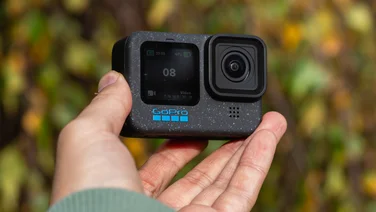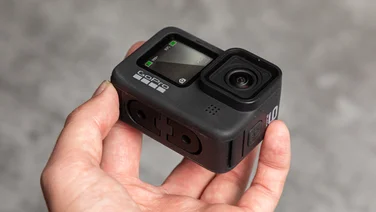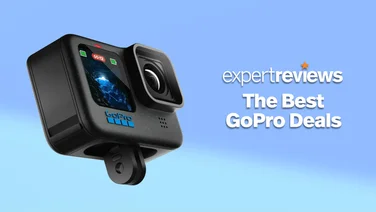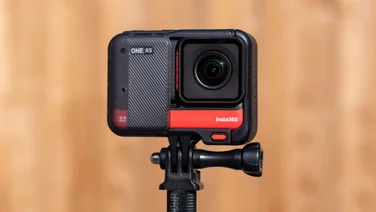To help us provide you with free impartial advice, we may earn a commission if you buy through links on our site. Learn more

- User-friendly
- Stimulating flight experience
- Lengthy 45-minute flight time
- Detachable wings for storage and transport
- 1.24-mile range
- Requires ample open space
- Some signal interruption at 250m+
A month or so ago, Parrot, eponymous producer of mid- and low-priced drones, did something unusual. It announced a new drone – not a quadcopter of the type everyone has been getting so overheated about for the past year or so – but a fixed-wing, single-rotor UAV (unmanned aerial vehicle), the Parrot Disco.
It was a real turn up for the books and an exciting development. But wait a minute. Aren’t fixed-wing aircraft incredibly tricky to pilot and amazingly easy to crash? Well, yes, but the Parrot Disco is no ordinary remote-controlled aeroplane, as I found out at an extensive hands-on session Parrot laid on at Kempton Park racecourse down in Surrey.
What’s so exciting about the Disco? Its main appeal is, in fact, that it’s far from tricky to fly; it’s just as accessible as any modern quadcopter. It’s as easy to take off and land it; it “hovers” (sort of), and you’ll be flying around with gay abandon in minutes. The only caveat is that you need a bit more space to fly it in than your average quadcopter, simply because it can go so fast, and it can’t land on a sixpence as quadcopters can.

Parrot Disco: Take-off, flight and landing
Take-off has to be the most impressive part of the whole Disco experience. With the Wi-Fi controller and battery in the drone charged up and powered on, you simply grasp one of the wings by its “shoulder”, press the take-off/land button on the remote with your spare hand and, once the rear-facing propeller fires up to full speed, fling the thing into the air.
As long as you’re gentle (don’t treat it like a frisbee or it will nosedive dramatically into the dirt), it then takes to the air, rising steeply, and completely automatically, proceeding to fly in autopilot mode at an altitude of 50m in lazy, 60m circles at a speed of 24mph. You don’t need to do anything at this point; in fact, you can simply leave it to circle if you want and make a cup of tea. It will continue to circle in “orbital standby mode” indefinitely until you take control and start to steer.

Once you do that, the fun starts. The Parrot Disco is incredibly responsive and, with its various safety features enabled, you can get stuck in without worrying too much about crashing or losing it. A downward-facing ultrasonic altimeter and camera work together to prevent you from flying it low, and you can set up a basic, circular geofence as well. Once the drone hits its limits, it will turn around all on its own and head back to base.
The most important thing about flying remote-controlled aircraft is responsiveness and reliability, and the Disco meets those demands admirably. The right stick on the control pad is used to bank right and left, gain height and dive, while the left stick is used to accelerate, decelerate and, with a quick flick right or left, enter its “orbital standby mode”.
In fact, it’s easier to get to grips with than a quadcopter in my book, although I wouldn’t want to fly one anywhere other than a wide, open expanse of country. If you make an error of judgement about direction or altitude at up to 50mph, it doesn’t take too long for things to go wrong, and there’s no forward-collision avoidance as there is with the very best drones.
Landing is the most tricky thing to pull off, but it’s still very difficult to stack it in spectacular fashion. The idea is to kill the altitude until you can fly no lower – ideally while flying it at yourself – then, when it’s 50m or so away, hit the landing button. The Disco will then cut the power, reverse its propeller briefly to scrub off speed and glide gently to earth. I think it will take a little more practice to get the Disco to land right at my feet, though.

Parrot Disco review: Features and FPV
Simply flying the Disco is fun enough, but there’s plenty more to it. There’s an electronically stabilised 1080p camera in the nose, which produces remarkably smooth footage, recording directly to 32GB of internal storage.
What’s more, the Disco is supplied with a smartphone-driven VR headset that streams live 720p video from the nose camera, directly to your eyeballs for the ultimate seat-of-your-pants flying experience. Once your phone is snugly docked in the headset’s docking tray, you hook it up to the controller via a USB cable, and don the goggles, just as you would with a Samsung Gear VR. The headset fits snugly and securely, and with a strap that stretches across the top of your head as well as a standard stretchy goggles strap, there’s no danger of it coming loose.

I found there was some breakup of the signal when the drone flew further than 250 metres away, and the view looked a little pixellated on the iPhone 7 I was using to test it out, but the wide angle of view provided an impressively clear view of my surroundings, and the display also overlays important telemetry onto that live image, so you know how fast you’re going, how high you’re flying and how much capacity the battery has to remain.
If something goes wrong – for example, if you fly beyond the range of the remote control, or you hit the limits of the geofence, the app displays a message in red on the screen so you know exactly what’s happening.
One nice touch is that, with a touch of the shoulder button on the control pad, you can activate the drone’s “see-through” mode. This patches through the view from your smartphone’s camera so you can get a handle on what’s going on immediately around you before switching back to cockpit view. If you prefer not to have the image fill your vision, it’s also possible to disconnect the goggles and view the live stream on the screen of your tablet or smartphone, which you can clip onto the top of the controller. It’s a very flexible, impressively capable FPV system.
The impressive specifications just keep on coming. Flight time is an-unheard-of 45 minutes where most quadcopters manage less than 30 minutes, range is 1.24 miles, and the brains of the Disco — housed beneath a clip-on flap on top of the fuselage — contain a mind-boggling array of sensory wizardry, all designed with one aim in mind: that of making flight child’s play. The C.H.U.C.K. (Control Hub and Universal Computer for Kit) contains GPS and GLONASS radios; an accelerometer, magnetometer and gyroscope; there’s a downward-facing camera and ultrasonic altimeter to help with landing and low-level flight; and a pitot tube on top of the Disco for sensing airspeed.
Once you’re an expert, it’s even possible to add an RC module to the flight bay that allows you to connect a full-blown enthusiast remote controller, although beware – by doing this you do lose out on the autopilot features. And when you’ve finished flying at the end of the day, you can clip off the wings and stow it in the boot of your car. Handy, since it’s quite a large thing – the wingspan is 1.15m, although it isn’t heavy to carry.

Parrot Disco review: Verdict
All told, I’m quite taken with the Parrot Disco. It’s great fun to fly, not intimidating at all and extremely easy to get to grips with. Even landing isn’t too traumatic, and although the price looks high, I think £1,150 for this lot is actually pretty good value. Frankly, I’m amazed Parrot has managed to squeeze so much in.
There is one potential problem here, and that’s one of space. In order to make the most of the Disco’s capabilities, you need a big, wide open area, much more so than with a quadcopter drone, and those spaces are thin on the ground in the UK, certainly in the South East where I live.
However, if you live near a suitable spot, or there’s a model aircraft club you can join, the Parrot Disco represents a practical and fun way to get into a hobby that previously had a much higher barrier to entry. It’s a blast.
Read our full roundup of the best drones for 2017







